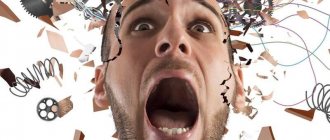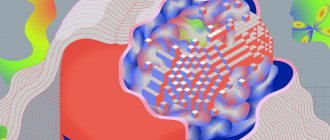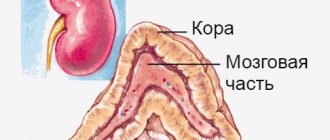Obsessive-compulsive disorder (OCD) is a mental disorder characterized by the appearance in the patient of obsessive thoughts, images, doubts (called obsessions), which destabilize the general state and cause severe anxiety. The patient tries to level out the discomfort by repeating actions (physical or mental), which doctors call compulsions or rituals. The second name of the disease is obsessive-compulsive neurosis.
Compulsive-obsessive disorder as a disease
Compulsive-obsessive disorder occurs among adults and children, approximately 1-2% of the world's population. The first signs appear in childhood. Seeing a doctor most often occurs after 10-15 years, when a person becomes an adult. Thus, the diagnosis is most often made to people between 20 and 40 years old.
Women are more prone to OCD. In a third of cases, OCD follows tic conditions. Advantageously, patients try to hide mental disorders from others or do not recognize them as symptoms of the disease.
In OCD, the person does not suffer from hallucinations. He is bothered by anxious thoughts (most often about the unfavorable outcome of some situation), which force him to constantly perform the same actions in order to reduce psycho-emotional stress. Obsessions can include:
- memories (for example, of being abused);
- visual images (in the form of pictures or stories)
- ideas (possible developments);
- involuntary fantasies (sometimes unrelated to reality);
- fears (a person is afraid of contracting a disease, being robbed or killed);
- doubts (regarding completed or unrealized actions).
As the disease progresses, anxiety increases, and obsessions appear more and more often, taking up more and more time, attention, and vitality. To alleviate his condition, a person performs certain actions or a set of them, most often in a specific sequence (for example, rechecking locks or electrical appliances, washing his hands or body, avoiding touching certain objects, keeping a count, or humming a song, out loud or mentally). Rituals can become more complex and time-consuming over time.
Most patients with OCD strive for solitude, suffer from depression, and even become incapacitated. The reasons for the development of OCD have not yet been established. Scientists associate the disorder with the peculiarities of mental and emotional memory.
Forecast
The prognosis, despite the fact that obsessive-compulsive disorder syndrome in most cases occurs in a chronic form and contributes to the formation of a neurotic personality type, is favorable in most cases. Complete recovery of patients is quite rare. Mild forms of the disease with adequate treatment can be stabilized throughout the year. Treatment of severe forms with the presence of numerous obsessions and complex rituals requires a longer time. In such cases, it is important to prevent/minimize cases of relapses accompanied by a slide into dysfunctional, habitual cognitive/behavioral attitudes. In severe cases, the disorder usually has a negative impact on the patient’s ability to work, which can cause disability.
Symptoms of compulsive-obsessive disorder
The main manifestations of OCD are considered to be a combination of obsessions of various types with rituals that arise in response to obsessions and are designed to reduce discomfort. Patients themselves characterize compulsions as an urgent need to perform a certain action in order to eliminate or alleviate anxiety due to unpleasant thoughts. The most common rituals:
- washing or cleaning something;
- endless checks of doors, locks, mechanisms;
- performing an action a certain number of times;
- putting items “in order” (dishes, stationery, clothes, small items).
Some compulsions are quickly noticed by others, while others (for example, pronouncing a phrase or counting) may not attract attention for a long time. The logical connection between obsessions and rituals is not always visible.
A characteristic feature of obsessive-compulsive disorder is the excessive manifestation of both obsessions and rituals to extinguish them. For example, taking a shower 3 times a day (so as not to get sick) seems insufficient for the patient and he decides to swim at least 10 times. Some people are aware of the redundancy of their own worries and attempts to eliminate them, others consider such behavior to be completely justified. Some patients consider only their own compulsions excessive, and therefore try to perform “rituals” in secret from others. Almost half of those with OCD lead to depression.
OCD may manifest itself in various variations. For example, some patients have more pronounced obsessions, while others have more compulsions. All types of disorders have a common feature (accompanied by increased anxiety, based on a sense of responsibility, guilt, fear).
According to a study by Canadian scientists, 80% of healthy people periodically experience obsessive thoughts, often during periods of stress, that seem strange or unacceptable to them. The difference with the disorder lies in the respondents' perception of these ideas. They consider them “spam” generated by the brain, do not pay attention to them and do not experience strong fear. Patients with OCD feel excessive anxiety about their thoughts and strive to get rid of them.
Helpful Resources for People with OCD
I return to Wikium, which I mentioned at the beginning of my article. I hope you have already visited the site, worked out on cool exercise machines, and added several of them to your bookmarks. In this block I will recommend several courses to you; I think they will be no less useful.
Brain fitness
Description. Eight of my readers bought this course. There were no negative reviews, everyone was happy. It is very expensive, but I always recommend it, and I put it first.
When you purchase Brain Fitness, the Wikium developers send you by mail a small device called a “neural interface”. This is an amazing thing that analyzes the electromagnetic waves coming from your brain. Look at the guy in the picture - he has a neural interface on his head.
The read fluctuations are then sent to the Vikium platform, where they are analyzed automatically. The analysis takes place in your personal account, when it is completed, you receive recommendations - what is wrong with your head, what should be done with it at the moment, and so on.
The device should be used when you are experiencing different emotional states. When you feel relaxed, or tense, depressed, when you are afraid or cannot get obsessive thoughts out of your head. Use the neural interface and compare the results.
The course itself is aimed at your personal development, getting rid of negativity and transitioning to an optimistic worldview. If you want, you can buy the neural interface separately, but I advise you not to give up the training program, it’s more effective.
Authors: developers of the Vikium project.
Cost: 12,990 rub.
Find out more and sign up for training
Brain Detoxification
Description . This course is already ten times cheaper, there is no neural interface here. In ten lessons, the teacher will teach you how to get rid of all the negativity in your head. From any negative and obsessive thoughts, bad memories, anxiety, fear, worries and so on.
There is a lot of practice in this course. You master the theory and begin training on specially designed exercises, as well as simulators from Vikium.
After paying for it, you will download all course materials to your PC, so they won’t go anywhere. If you want to ask questions or something is unclear to you, the teacher is in touch.
The simulators themselves are very exciting, they give you the opportunity to relax and unwind.
Authors: developers of the Vikium project.
Cost: 1,490 rub.
Find out more and sign up for training
Emotional intellect
Description. I also recommend that you take the emotional intelligence course. Understand the emotions (your own and those around you), learn to manage them better. Essentially, OCD occurs because the mind is unable to gain control over emotions. Negative thoughts are spinning in your head because you are driven by fear, anger, envy or various other feelings.
The theory in this material is packed into twenty lessons, you will go through them very quickly. There are exercises and simulators to develop practical skills.
The course will not only help you cope with panic attacks more easily or get out of OCD completely, but will also make it easier to communicate with people around you, teach you how to react correctly to their actions, etc.
Authors: developers of the Vikium project.
Cost: 1,490 rub.
Find out more and sign up for training
If you know of other good courses for people with OCD, or maybe you have attended webinars on this topic, read books that helped you come to your senses, tell us about them in the comments. I will supplement my article with your recommendations.
How to diagnose yourself?
If you suspect OCD, you should seek help from a psychotherapist. Warning signs that may indicate a violation include:
- the regular appearance of the same thoughts or images, which the person himself considers unpleasant, strange, unacceptable;
- the appearance of such ideas always brings discomfort, causes anxiety, you want to get rid of them as quickly as possible, but the thoughts involuntarily appear again and again;
- a person notices that thinking about unpleasant things takes at least an hour a day or more;
- obsessions interfere with work, enjoyment, and daily activities;
- Gradually, thoughts and the struggle with them crowd out other activities.
Even if the patient himself considers his ideas wrong or dangerous, and the reaction to them is stupid and stupid, you need to seek help. Embarrassment may prevent the patient from sharing problems with loved ones, then it is better to make an appointment with a psychotherapist on your own.
The specialist will conduct special tests and help determine whether the situation is the result of stress or a mental disorder. Treatment in the early stages may only involve psychotherapeutic methods (conversations, games, following simple recommendations). In the later stages of development of compulsive-obsessive disorder, medications will have to be used.
Diet
Diet for the nervous system
- Efficacy: therapeutic effect after 2 months
- Timing: constantly
- Cost of food: 1700-1800 rubles per week
Diet for depression
- Efficacy: therapeutic effect after 1-3 months
- Dates: no data
- Cost of products: 1700-1800 rubles. in Week
The influence of various micronutrients on the functions of the central nervous system, emotional reactions/mood and, in general, on the general condition and well-being of a person has been reliably proven. A lack of micronutrients in the body (magnesium, iron, B12, B1, B6, C, B2, folic acid) leads to an imbalance of neurotransmitters, including those that are actively involved in the synthesis of serotonin .
A rationally formed diet containing a sufficient amount of minerals/vitamins will help reduce the manifestations of negative symptoms. For obsessive-compulsive neuroses, patients are recommended to follow the Diet for the Nervous System , and for patients with comorbid disorders in the form of depressive disorders, the Diet for Depression .
Treatment methods for compulsive-obsessive disorder
There are 2 main approaches to combat obsessive-compulsive disorder. The first is aimed at obsessive actions (exposure method), and the second is aimed at disturbing thoughts.
The exposure method involves patients consciously strengthening their obsessive reactions, up to the absurdity of the situation. A person internalizes the irrationality of his actions, which helps soften the reaction to obsessive thoughts. The emotional state is corrected with the help of psychotherapy. To eliminate obsessions, the specialist teaches the patient to track and separate logical and emotional connections among themselves in order to correct the course of thoughts and reaction to them.
Prevention
Since the etiology of obsessive states has not been identified, preventive measures are advisory in nature. Primary prevention is aimed at preventing the development of neuroses of this type, through proper child upbringing, teaching adolescents methods to increase stress resistance, and general strengthening of the body.
Secondary prevention is aimed at preventing relapses, which is achieved through periodic medical correction of the patient’s mental state, psychotherapeutic sessions, following the recommendations of the attending physician, avoiding the abuse of psychoactive drugs/alcohol, and introducing into the diet foods containing tryptophan , which is a precursor of serotonin . It is necessary to carefully monitor the appearance of the first mild signs of the disease. Patients with psychopathic character traits should be periodically/continuously prescribed mild antipsychotic drugs ( Thioridazine , Neuleptil ).
Drug treatment for obsessive-compulsive disorder
In the treatment of OCD, pharmaceuticals play a secondary role. They are prescribed only when conducting cognitive behavioral therapy is difficult for some reason. Stress and depression can make it difficult for the patient to concentrate, which is important for working productively with thoughts and emotions.
Drugs
To treat OCD, sedatives, antidepressants, and serotonin reuptake inhibitors may be prescribed. The latter play a major role, since in OCD, fluctuations in the level of this enzyme (neurotransmitter) are often detected. The effectiveness of drug therapy is assessed after 2-3 months. If the required result is not achieved, a second-line agent is prescribed - Clomipramine (a tricyclic antidepressant).
Getting rid of OCD is real Come to us and we will help
Pathogenesis
There is no single view on the pathogenesis of this disease. There are many hypotheses and theoretical studies, but none of them provides a comprehensive answer to the specifics of the development of obsessions. The neurochemical and neuroanatomical theories have the greatest support.
Neurochemical theory
It is based on disorders of serotonin . There is a fairly large amount of reliable data confirming the leading role of serotonin metabolism and disorders in the frontal-basal-ganglionic-thalamo-cortical circle. According to this theory, due to a decrease in the release of serotonin, the ability to influence the mechanism of dopaminergic neurotransmission begins to sharply decrease, which causes an imbalance in the systems and contributes to the development of an imbalance leading to dominance of dopamine activity in the basal ganglia. This mechanism underlies the development of stereotypic behavior and various motor disorders. Since serotonergic efferent pathways go to the structures of the frontal lobe of the cerebral cortex (limbic structures and orbital gyri of the frontal lobes of the brain) from the basal ganglia, its damage is responsible for the appearance of various kinds of obsessions. It is assumed that insufficient levels of serotonin, which is based on increased reuptake by neurons, stop the process of transmitting impulses from neuron to neuron (Fig. below).
Neuroanatomical theory
The neuroanatomical basis for the development of obsessions is based on dysfunction of the frontal lobe. Evidence of neurobiological disorders is the connection of this disorder with various kinds of pathologies, which are based on pathological processes in the basal ganglia ( Tourette's syndrome , Sydenham's chorea , lethargic encephalitis ).
Advantages of treatment at the clinic Solution
If you suspect mental disorders, you should contact the Solution clinic. An anonymous number is listed on our website. By calling it, a person quickly receives expert help and recommendations regarding future actions.
Clinic Solution offers a full range of counseling and therapeutic services to eliminate mental health problems, as well as to combat chemical dependency. Patients are assisted by highly qualified specialists with extensive practical experience (more than 16 years), who use unique therapeutic techniques.
“I thought others didn’t notice my rituals”
By the age of 19, I had already had two exacerbations, but I still had no idea what was happening to me, and did not even imagine that this could be a deviation. One day I was sitting at home, watching TV with my mother. MTV started a program about a woman with a mental illness, they often showed something similar about obesity, anorexia and other “exotics” that over time became so well known to us. This woman could not touch door handles; she walked on the floor with disposable towels soaked in antiseptic tied to her feet. She was afraid of germs. (This, by the way, is a classic OCD - fear of germs as a source of threat. My fear of genetic diseases and fatal diseases is a relatively rare case.) She washed her hands endlessly, and if she accidentally touched the faucet or sink, she started over. Her little child, who had barely learned to walk, repeated everything after her and “played” washing his hands. She cried and said that she had ruined her son's life.
At first I didn’t pay attention to this transmission, it was just something going on in the background. And my mother looked and suddenly told me sternly: “Look what your life will be like if you don’t pull yourself together.” It was strange - I thought my mother and other people didn’t notice my rituals.
Alice, Munchausen, Peter Pan. What unusual syndromes do people exhibit? More details









